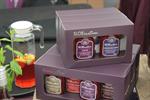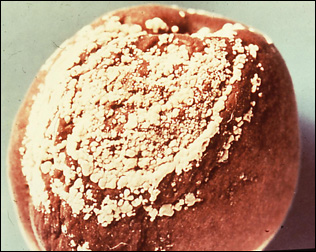Food Spoilage
What Causes Food Spoilage?
 Food spoilage is caused by microbes. The rate of spoilage depends on micro-organisms is dependent on the ability of these microbes to grow and multiply. This is in turn affected by a range of factors such as water, pH, oxygen and temperature as well the physical structure of the food itself. Foods that spoil most rapidly are those that are moist, of neutral pH, are unrefrigerated and ground or sliced. In contrast dry, acidic and refrigerated foods are more resistant to spoilage.
Food spoilage is caused by microbes. The rate of spoilage depends on micro-organisms is dependent on the ability of these microbes to grow and multiply. This is in turn affected by a range of factors such as water, pH, oxygen and temperature as well the physical structure of the food itself. Foods that spoil most rapidly are those that are moist, of neutral pH, are unrefrigerated and ground or sliced. In contrast dry, acidic and refrigerated foods are more resistant to spoilage.
pH
PH is a measure of how acidic or alkaline something is. Environments that are acidic have a pH below 7 and environments that are alkaline have a pH over 7. Micro-organisms tend to thrive at a neutral pH of between 6.6 and 7.5 whereas most bacteria are inhibited at a pH below 4, although yeast and moulds can tolerate lower pH levels.
Water
Water is an important constituent of all foods, and even relatively dry foods such as bread and cheese contain over 35% water. Generally, a lack of water inhibits microbial growth. Bacteria in particular, are unable to grow and multiply in dry environments. This is why drier foods are most likely to be spoiled by yeast and mould which can survive in slightly drier environments. Availability of water is affected by drying foods and by adding salt or sugar to foods
Oxygen
Oxygen can cause food spoilage by enhancing the action of food spoilage micro-organisms as most micro-organisms require oxygen to grow and multiply. Oxygen also aids the action of the enzymes involved in food spoilage and is capable of causing oxidative damage to foods by itself e.g. causing oxidative damage to the fat portion of food causing foods to have a strong smell and taste rancid.
Structure of food
Grinding foods increases the surface area of foods producing a greater surface area for microbial growth. Meanwhile, the presence of an outer covering on food such as the skin on fruit and vegetables acts as a barrier to microbes, this is why fruits such as lemons last longer when they are whole and covered in rind rather than when they have been sliced.
Foods can also have natural protection from micro-organisms e.g. cranberries produce benzoic acid which has anti-fungal properties and egg whites contain lysozyme which has antibacterial properties
Reducing food spoilage by micro-organisms
An understanding of the causes of food spoilage can help to suggest interventions to prevent spoilage occurring. Here are some factors to consider:
 Cover food or pack foods carefully to prevent the invasion of micro-organisms. Also remove spoiled foods that are close to unspoiled foods to prevent cross contamination and remove any micro-organisms present on foods; for example, by washing salad vegetables.
Cover food or pack foods carefully to prevent the invasion of micro-organisms. Also remove spoiled foods that are close to unspoiled foods to prevent cross contamination and remove any micro-organisms present on foods; for example, by washing salad vegetables.- Lower the temperature a food is stored in to prevent microbial growth. Optimal temperature are below 5° Celsius for refrigerated foods.
- Reduce the availability of oxygen to foods by using appropriate food production methods and packaging which minimises the oxygen available to foods. Also consider adding antioxidants to food where appropriate as these help to absorb oxygen and slow down the rate of oxidation, examples of antioxidants include vitamin C and vitamin E.
- Consider adding preservatives to foods such as salt, sugar and vinegar, which are natural preservatives, and sodium chloride and citric acid which are chemical preservatives.
- Reduce physical damage of foods by handling foods carefully; for example, taking care when picking fruits and vegetables, and taking care when packing and transporting foods.
- Kill micro-organisms present in foods e.g. by cooking foods appropriately and pasteurising foods. However, sometimes this aspect of food preservation can be a balance between killing microbes and producing a quality food product; processing that kills all the micro-organisms in a food can also affect the taste, texture and nutritional content of a food.
- Increase the acidity of food e.g. by adding an acid such as acetic acid.
What is the Best Way to Preserve Food?
When you come to choose a method of food preservation your choice will depend on a number of factors including the type of food you are preserving, the equipment you have access to or the cost of equipment you would need to buy. You will also need to consider the anticipated quality of the product after preserving it, and for how long you would like to store a preserved product.
Type of food
Different foods lend themselves to different methods of food preservation and storage. Some foods are suited to storage at room temperature such as dry pasta, cereal, bread and flour, whilst other foods are most suited to cold storage such as milk and dairy products, eggs, meat and cooked foods.
When choosing any food preservation technique it is important to consider the end product. Some foods are best eaten fresh and do not tolerate food preservation techniques at all or the end product is compromised.
When selecting food to preserve, always aim to select the freshest and highest quality products. For example, when choosing fruit and vegetables, pick products that are at the best stage of maturity, i.e. do not pick under-ripe fruit or immature vegetables, and discard fruit and vegetables that show any sign of disease.
Learn with ACS
Learn more about food and nutrition with ACS. We offer a wide selection of courses to teach you more about food - selection, preparation, storage, and nutrition. Whether you are looking to study for your own interest, or you work in the hospitality industry, or you are looking to coach others. Our courses include Food Preparation, Food Processing And Technology, Foundation Diploma In Nutrition.
Our academic faculty includes specialist tutors in Health Science, Hospitality, Fitness, and Counselling. In addition to their qualifications they have extensive experience within their fields. Students studying with ACS have unlimited access to their tutors who are their to support and guide them with their studies.
All of our courses are studied by distance learning and can be started at any time. If you have any questions or want to know more, please get in touch with our expert tutors today; they will be happy to answer any questions and discuss different study options to meet with your aims.
[19/04/2024 00:29:23]
More from ACS
Directory to dozens of courses -short courses, certificates and diplomas
Short courses, certificates, diplomas -lots of study options.
Learn to eat a balanced diet.
Are there things you just should not eat?